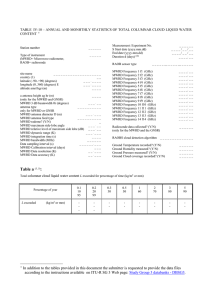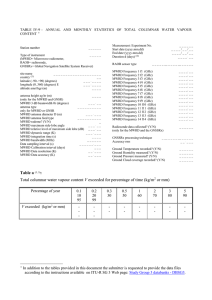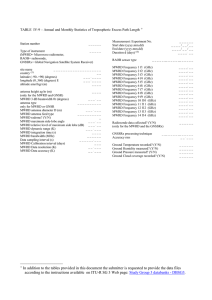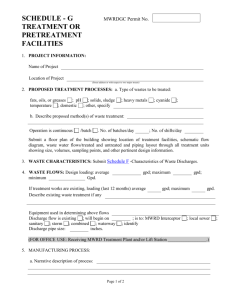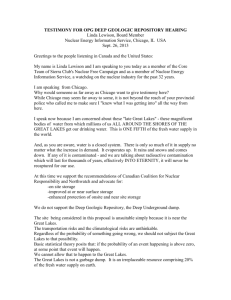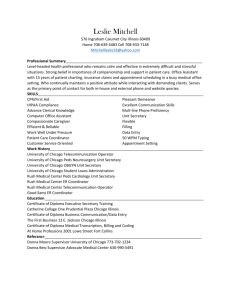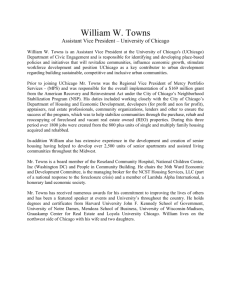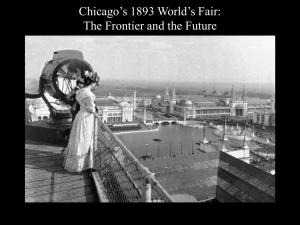MWRD - Sierra Club, Illinois Chapter
advertisement
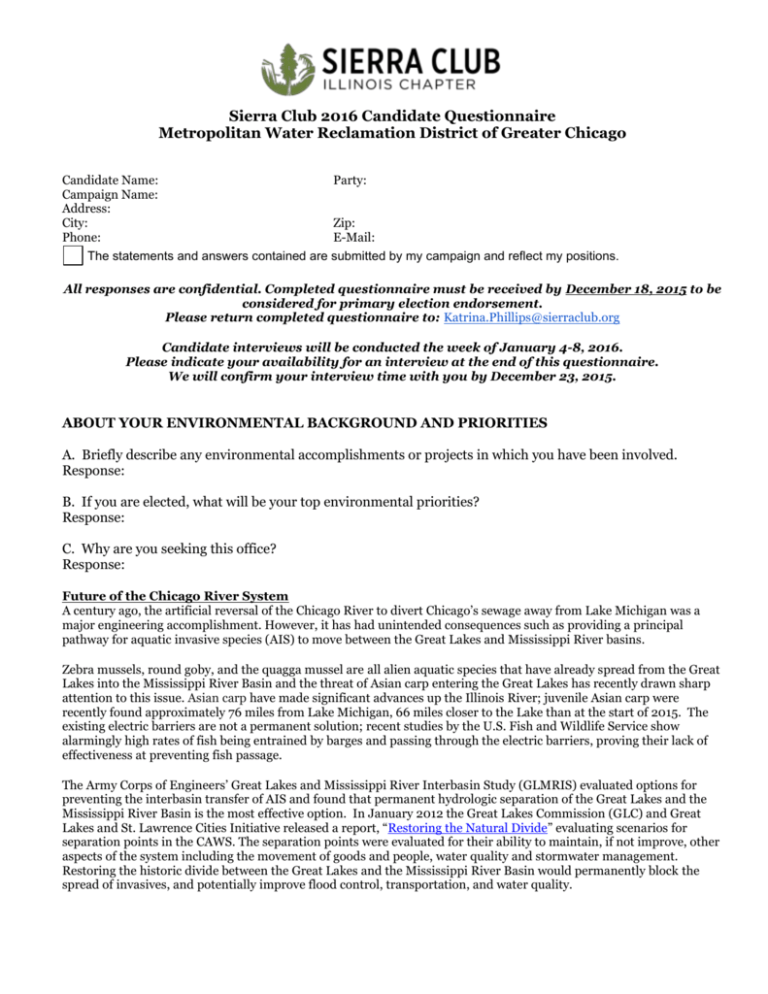
Sierra Club 2016 Candidate Questionnaire Metropolitan Water Reclamation District of Greater Chicago Candidate Name: Campaign Name: Address: City: Phone: Party: Zip: E-Mail: The statements and answers contained are submitted by my campaign and reflect my positions. All responses are confidential. Completed questionnaire must be received by December 18, 2015 to be considered for primary election endorsement. Please return completed questionnaire to: Katrina.Phillips@sierraclub.org Candidate interviews will be conducted the week of January 4-8, 2016. Please indicate your availability for an interview at the end of this questionnaire. We will confirm your interview time with you by December 23, 2015. ABOUT YOUR ENVIRONMENTAL BACKGROUND AND PRIORITIES A. Briefly describe any environmental accomplishments or projects in which you have been involved. Response: B. If you are elected, what will be your top environmental priorities? Response: C. Why are you seeking this office? Response: Future of the Chicago River System A century ago, the artificial reversal of the Chicago River to divert Chicago’s sewage away from Lake Michigan was a major engineering accomplishment. However, it has had unintended consequences such as providing a principal pathway for aquatic invasive species (AIS) to move between the Great Lakes and Mississippi River basins. Zebra mussels, round goby, and the quagga mussel are all alien aquatic species that have already spread from the Great Lakes into the Mississippi River Basin and the threat of Asian carp entering the Great Lakes has recently drawn sharp attention to this issue. Asian carp have made significant advances up the Illinois River; juvenile Asian carp were recently found approximately 76 miles from Lake Michigan, 66 miles closer to the Lake than at the start of 2015. The existing electric barriers are not a permanent solution; recent studies by the U.S. Fish and Wildlife Service show alarmingly high rates of fish being entrained by barges and passing through the electric barriers, proving their lack of effectiveness at preventing fish passage. The Army Corps of Engineers’ Great Lakes and Mississippi River Interbasin Study (GLMRIS) evaluated options for preventing the interbasin transfer of AIS and found that permanent hydrologic separation of the Great Lakes and the Mississippi River Basin is the most effective option. In January 2012 the Great Lakes Commission (GLC) and Great Lakes and St. Lawrence Cities Initiative released a report, “Restoring the Natural Divide” evaluating scenarios for separation points in the CAWS. The separation points were evaluated for their ability to maintain, if not improve, other aspects of the system including the movement of goods and people, water quality and stormwater management. Restoring the historic divide between the Great Lakes and the Mississippi River Basin would permanently block the spread of invasives, and potentially improve flood control, transportation, and water quality. MWRD has participated in meetings of the CAWS Advisory Committee, a group of stakeholders working towards consensus recommendations for short- and long-term measures to prevent Asian carp and other AIS from moving between the Mississippi River and Great Lakes basins through the CAWS. The leadership and active engagement of MWRD in envisioning the future of the CAWS is essential in ensuring that measures are implemented to prevent the transfer of AIS while providing flood control and water quality improvements for our region. 1. Would you support the permanent separation of the Great Lakes and Mississippi basins, if it can be implemented in a manner that protects Lake Michigan water quality and reduces flooding? Yes No Comment: 2. Would you be in favor of the District taking a lead role with the Army Corps of Engineers and other local stakeholders to design plans for a Chicago Area Waterway system that prevents the interbasin transfer of aquatic invasive species while also improving flood control and water quality? Yes No Comment: 3. What other actions do you think the District should be taking to address the threat of Asian carp and other aquatic invasive species moving between the Great Lakes and Mississippi basins through the CAWS? Explain: Controlling Nitrogen and Phosphorus Pollution Nutrient pollution from excess phosphorus and nitrogen is causing major problems for water quality and wildlife in many parts of Illinois, including downstream of MWRD’s treatment plants. Nitrogen and phosphorus pollution can adversely affect freshwater systems by overfeeding algae, causing algal blooms that suck up the available oxygen. Algal blooms harm aquatic life and destroy the aesthetic and recreational value of waterways. Phosphorus can also cause high levels of cyanobacteria in lakes and rivers, leading to problems with drinking water supplies and even creating conditions poisonous to people, pets, and wildlife. The Chicago River Watershed, as part of the Mississippi River Basin, has been ranked as one of the top contributors of phosphorus and nitrogen to the Gulf of Mexico, where a dead zone exists as a result of this pollution. MWRD is not yet required to remove nutrients from the discharges from the majority of its facilities. However, most major wastewater treatment plants in the Great Lakes watershed include treatment for phosphorus and nitrogen. MWRD’s three largest plants received new permits in 2013 that require some reduction in their phosphorus discharges by 2023 at the latest. Illinois also recently released its Nutrient Loss Reduction Strategy, which calls for 45% reductions in the amount of nitrogen and phosphorus leaving the state. Although excess nitrogen and phosphorus cause problems in our waters, they are also potentially valuable commodities. Recently, the District has launched the world’s largest nutrient recovery project at its Stickney facility. 4. Do you support MWRD reducing discharges of phosphorus and/or nitrogen from its treatment plants? Yes No Comment: 5. While the District is working to reduce nutrient discharges from some of its plants, it has not yet determined the level of nutrient reductions and other steps that need to be taken to resolve problems with nuisance algae and low dissolved oxygen levels in the CAWS, Lower Des Plaines River and Upper Illinois River. Should MWRD spearhead an effort to reduce nutrient inputs and take other steps to assure the District is not contributing to violations of water quality standards in downstream waters? Yes No Comment: In Cook County our soils have plenty of phosphorus to maintain normal healthy lawns. Therefore, most of the phosphorus found in fertilizers offered for retail sale or from professional applicators is unnecessary and contributes to polluting our watersheds. Illinois has banned lawn care companies from using fertilizers containing phosphorus, but the State does not have resources to adequately enforce the ban. Several Illinois communities have taken steps to prohibit or limit the sale of phosphorus-containing fertilizer at retail stores. 6. Would you support a new ban on retail sales of phosphorus-containing lawn fertilizer in Cook County? Yes No Comment: The DuPage River Salt Creek Workgroup (DRSCW) is a voluntary effort among a group of communities, publiclyowned wastewater treatment plants, and environmental organizations working to attain water quality standards and designated uses for Salt Creek and the East and West Branches of the DuPage River. Although two of MWRD’s plants discharge to these waterways, MWRD has not yet joined the DRSCW’s efforts to collectively fund river restoration projects targeted on the aquatic life goal of the Clean Water Act. The projects have been selected to maximize improvements in fish and macroinvertebrate communities. 7. Would you support MWRD funding a portion of the DRSCW’s effort to work together with other wastewater treatment facility operators, communities and environmental groups to improve water quality and habitat in these waterways? Yes No Comment: Endocrine-Disruptors and Chemicals of Concern Endocrine-disrupting compounds are chemicals that interfere with natural hormones in the bodies of people and wildlife. Endocrine disruptors are components of many consumer products, pharmaceuticals, and industrial products, and therefore are present in the effluent and biosolids from MWRD’s treatment plants. MWRD’s plants, therefore, are a major contributor of these pollutants to the CAWS, the Des Plaines, West Branch of the DuPage River and Salt Creek. The District has a legacy of affecting policy in the consumer arena by leading the removal of polluting phosphorus from detergents. MWRD could now be a leader in protecting water quality and public health from these emerging contaminants by supporting pharmaceutical take back programs, advocating for limits or the elimination of chemicals like nonylphenol (NP), triclocarban (TCC) and triclosan (TCS) in consumer and industrial products. The presence of these compounds in MWRD’s effluent and biosolids combined with the emerging science around endocrine disruptors and chemicals of concern should galvanize the agency into acting on this emerging class of pollutant. In an effort to reduce contamination of streams, rivers and lakes, the MWRD has participated in the U.S. Drug Enforcement Administration Chicago Field Division's annual Prescription Drug Take-Back Day since the event was launched in 2010. The success of these events show how effective a permanent, robust pharmaceutical take-back program could be in the Chicago area. 8. Would you support efforts to establish a robust pharmaceutical take-back program to protect public health and water quality? Yes No Comment: 9. Do you support MWRD attempting to identify the sources of pollutants like NP, TCC and TCS and support product bans or other efforts to limit the amount of endocrine disrupting pollutants entering MWRD’s plants? Yes No Comment: 10. If no, what actions would you support MWRD taking to address pharmaceuticals or other emerging contaminants? Explain: Managing Stormwater Climate disruption is leading to severe and more frequent storm events, which has increased flooding of our homes and contributes to the degradation of Cook County rivers and streams. Storm sewers, which are increasingly overwhelmed by the volume of water from rain events, funnel fast moving water that carries pollution from streets, parking lots and yards directly into our water. Further, the speed of the water destroys stream banks by eroding the soil. MWRD’s passage of the Watershed Management Ordinance in October 2013 was a milestone achievement in addressing stormwater issues, but additional measures will be needed. One way to reduce problems caused by stormwater runoff is to promote practices that capture, retain and infiltrate rainwater on site. Such practices include detention, rain gardens and porous pavement. Slowing water down before it reaches our streams will help remove pollutants, prevent stream bank erosion and preserve habitat. The use of green infrastructure like rain gardens and Chicago’s green alleys has the potential to help reduce runoff from storm events and improve water quality. MWRD entered into a settlement agreement with the Dept. of Justice and the US EPA in 2011 to redress violations of the Clean Water Act caused by combined sewer overflows. The Consent Decree includes a Green Infrastructure program that is estimated to cost between $25 and $50 million. The Green Infrastructure Plan must include projects that reduce flooding and basement back-ups and address areas impacted by environmental justice (socio-economic) concerns. However, the amount of green infrastructure being required is small compared to similar settlements the US EPA has made with other large cities like New York City ($187 million within the first five years and more than $1 billion over 20 years), Philadelphia ($1.67 billion over 25 years) and St. Louis ($100 million). 11. Do you support the increased use of green infrastructure? Yes No 12. If yes, what additional priorities would you propose to expand green infrastructure in MWRD’s territory? Explain: Waterways such as Bubbly Creek are increasingly being used for recreational activities such as rowing and paddling, but users are forced to risk their health to do so because of the poor water quality and frequent combined sewer overflows which release dangerous substances into the water. The MWRD’s Racine Avenue Pumping Station and many other parts of the infrastructure system discharge untreated wastewater into the waterway when the sewer system is overwhelmed. 13. What actions would you support the MWRD take to improve conditions in Bubbly Creek and other waterways to reduce the risk of public threat healths for recreational users? Explain: Land Ownership & Public Access The MWRD is one of the largest landowning government entities in the Chicagoland region. Significantly, most of this land is along the highly valued waterways and contains valuable open space and wildlife habitat. Within Chicago city limits, 20% of the riverbank is owned by the MWRD. 14. Would you support the permanent protection of MWRD holdings that are suitable as habitat or recreation areas by transferring ownership or management to a public land agency? Yes No Comment: 15. What goals do you want to see the MWRD adopt as regards habitat restoration and the creation of wetlands on lands under District’s ownership? Explain: 16. Historically the District has given preference when leasing its lands to open space agencies (forest preserve districts, park districts, schools, etc.). Leases often ran for 99 years for $1. Should the District maintain this practice or seek to maximize revenue by leasing land to the highest bidder? Yes No Comment: 17. Will you support the MWRD working with the City of Chicago and other communities where the District owns riparian property to promote recreation and public access to waterfront trails and water trails? Yes No Comment: Aquatic Habitat Restoration and Creation A combination of factors including the built environment, channelization, loss of wetlands and unnatural flow regimes has resulted in degraded habitat throughout the Chicago River System. Additionally, periods of stagnant water flow followed by spikes of stormwater runoff deteriorate stream banks, which further degrades habitat and water quality. A major obstacle to restoring a healthy fishery in the Chicago River system is a lack of habitat such as wetlands and side channels because a majority of the waterways are lined with hard surfaces or sheet metal pilings. Projects including fish hotels, pool and riffle creation, improved instream habitat in the North Shore Channel, and the proposed transformation of the stockyards on Bubbly Creek to a wetland park are the type of innovative projects that will help revitalize an active fishery on the Chicago Area Waterways System. 18. Do you support consideration of plans like those for Bubbly Creek to increase fish and wildlife habitat in the Chicago Area Waterways System? Yes No If so, which plans do you believe should receive further study? Explain: Working with City of Chicago The Chicago of Chicago is one of the major units of government in MWRD’s service area. The City of Chicago’s exciting goals get more people on and along the Chicago River are possible because of MWRD investments, such as disinfection controls, and further improvements in water quality will lead to more economic and recreational opportunities. How the City deals with combined sewer overflows and stormwater runoff affect MWRD’s ability to clean up the stormwater and wastewater that the District discharges to Chicago Area Waterways. Clearly there are many opportunities for the City and the District to work together to improve water quality and flood control. 20. What could you do as a commissioner to foster a strong working partnership with City of Chicago elected officials and staff? Explain: Please indicate below all times that you would be available for a 30-45 minute interview. We will let you know when we have scheduled your interview by Dec. 23, 2015. Your interview will be held at the Sierra Club office at 70 E Lake St., Ste 1500, Chicago. Tuesday, January 5 5 PM 6 PM 7 PM 8 PM Wednesday, January 6 5 PM 6 PM 7 PM 8 PM 7 PM 8 PM Thursday, January 7 5 PM 6 PM

